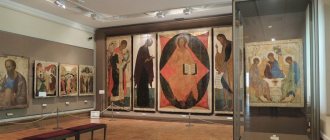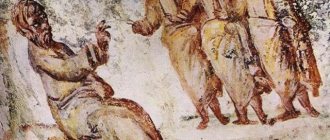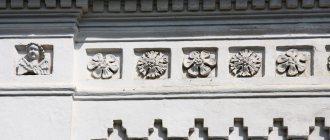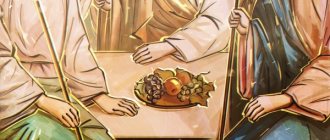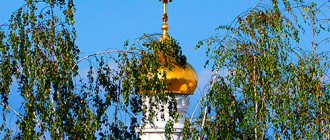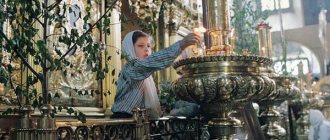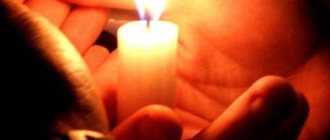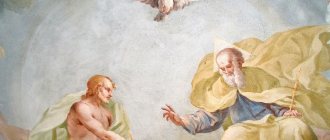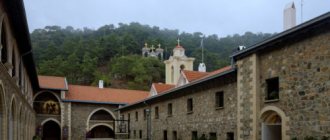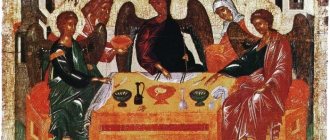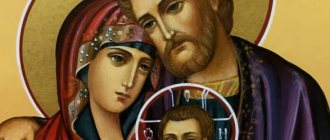- Autumn of the Russian Middle Ages
Share
Simon Ushakov repeatedly addressed the theme of the Old Testament Trinity, but only one large icon of his work with such an image has survived to our time. He wrote the second monumental work on this topic in 1677 together with Nikita Pavlovets (MGOMZ).
The image of the Old Testament Trinity embodies the fundamental dogma of the Christian religion, according to which God is one in three Persons - the Father, the Son and the Holy Spirit.
The Old Testament tells how God appeared to the hundred-year-old righteous old man, forefather Abraham, in the form of three wandering angels. Abraham and Sarah treat travelers under the oak of Mamre. Angels predict the birth of their son Isaac.
The artist sought to get rid of the conventional canons of icon painting, to achieve three-dimensionality, physicality of figures and faces. The perspective construction of the composition is reminiscent of the architectural backgrounds of Renaissance paintings. Here the shapes of the “chambers” are reminiscent of the paintings of P. Veronese, and the iconography goes back to Rublev’s “Trinity”. However, this work does not carry the high spirituality that was inherent in the creations of Andrei Rublev. The angels here look like completely living creatures, and the table with a cup - a symbol of the sacrament of the sacrifice of atonement - has turned into an ordinary still life.
A unique feature of the icon is the depiction of the chambers of orders. The question of their iconographic source was partly resolved by N.P. Sychev, who indicated architectural fantasies in Paolo Veronese’s painting “The Feast of Levi the Publican” (Accademia Gallery, Venice) as their indirect prototype. The city view on the right side of the canvas is connected with the portico on the icon of the Russian Museum through intermediate iconographic links. Probably among them was an engraving from Merian's illustrated Bible, in which a similar “veduta” is visible on a sheet with the prophet and King David playing the harp in the background.
The color of the icon harmoniously combines white, red and beige, brownish-green and dark green, gold and silver, enriched with lilac and red varnish. Pink and purple play an important role, used in painting the robes and wings of angels. The wings themselves make an unusual impression due to the “life-like” interpretation of the feathers with the shaft and barbs painted in gold or silver, as well as the absence of subferns. This image of wings can be found in other works of Simon Ushakov, for example on the Royal Doors of 1672 from the cathedral church of the Chudov Monastery (Moscow Kremlin Museums). Along with the white chambers visible in the archway and the white tablecloth, the brightest spots in the composition are the faces framed by lush soft curls. Thin pink ribbons are woven into the angels' hair. The eyes and lips of the heavenly messengers are painted in the recognizable Ushakov style. Due to multi-layered writing, Simon Ushakov achieved the impression of three-dimensionality of shape and relief of volume. Moreover, each angel is given an individual appearance.
P. V. Zapadalova // Autumn of the Russian Middle Ages. SPb. 2021. P. 72.
It remains unknown for which temple the icon was intended, but we know the name of its customer. It has been established that Nikolai Nicoletta was a Greek, a native of the city of Ioannina, who came to Moscow “with paid Russian polonyaniki” and all sorts of goods, and in 1679 he permanently moved to the capital of the Muscovite kingdom.
At the lower border of the centerpiece in the center there is an inscription in white: [In the year from Adam 7180, from the Nativity of Christ 1671, October 16, by the zeal of the royal master named Pimen Fedorov, nicknamed Simon Ushakov, in the city of Moscow. With the care and expense of Nikolai Evstafiev Nikoleta] (translated by B. L. Fonkich). The second inscription in Russian: “For the repose of schema monk Filaret, schema monk Savvaty, schema monk Sergia.”
Discovered in 1926–1927 at the State Russian Museum by I. Ya. Chelnokov, in 1936 by Ya. V. Sosin.
Similar cloud marks with the composition “Old Testament Trinity”, the entire background of which is covered with golden horizontal strokes, are found in the upper part of Simon Ushakov’s icons “St. Macarius of Unzhensk” (1661, NGIAMZ) and “Great Martyr George” (1677, National Museum of Georgia). All four images of the Holy Trinity are united by belonging to a brief summary of iconography: apart from the three angels, no additional characters are presented here.
The compositional features of the “Holy Trinity” of 1677 and a similar image by Ilya Filippov of 1673 (?) (PGHG) allow us to speak about the conscious appeal of the masters of the Armory to the iconography of the revered and attributed to Andrei Rublev icon from the Trinity Cathedral of the Trinity-Sergius Monastery. They do not coincide with it in size, but the similarity of the compositions - the mutual relationship of the poses and gestures of the three angels, the general design of the contours of their clothes, wings and staffs, the shape of the chamber in the background, the outlines of the table, footstools and seats, the presence of only one bowl on the table - confirms the correctness of this assumption. In comparison with the icons of 1673 (?) and 1677, the image in question is less similar to the famous protograph.
Source
24. Comparative analysis of the Trinity icon by A. Rublev and S. Ushakov
The combination of old and new trends is especially noticeable in the icon of Simon Ushakov “Trinity”. Taking the old iconographic composition scheme as a basis, the artist, trying to show the divine essence of his characters, abundantly covered their clothes with golden lines, paying great attention to the golden background on which the action unfolds. The faces and hands of the angels are conveyed, however, in such a three-dimensional manner that they have not been depicted until now. In constructing the composition, the artist used some elements of direct perspective, unfamiliar to the old Russian masters.
In the shape of the building placed in the background, the features of Renaissance architecture, obviously known to Ushakov from the engravings that were distributed at that time, are clearly perceptible.
One of the typical works of Simon Ushakov, the Trinity icon, was created by him during the period of creative maturity. As the main compositional scheme, mainly in the construction of the central group of angels, Ushakov used the famous “Trinity” by Andrei Rublev.
But at the same time, he changed its entire spirit and meaning so much that the viewer will feel the difference between the two works of the same name rather than the similarity.
By placing emphasis on everyday moments, strengthening the material interpretation, he thereby gives the icon a secular character and at the same time deprives it of the spirituality and philosophical sound that constitute the essence of Rublev’s work.
If you compare these two icons, you can immediately notice that Ushakov reworked the original, that is, Rublev, the folds of the angels’ clothes are not as pointed as Rublev’s.
The commonality of these images and drawings allows us to interpret Ushakov’s work as a repetition of Rublev’s image, only - the heads of the angels are bowed differently, the surrounding background is different, but the basis of these differences is not Ushakov’s desire to create a different icon, but simply different ideals of the eras.
Source
Biography
Ushakov (Simon or Pimen) Fedorovich (1626-1686) presumably came from the townspeople. Already at the age of 22, he was accepted into the royal “granted” (i.e., receiving permanent support) masters of the Silver Chamber under the Armory Order.
He made drawings for items of church utensils and palace furniture, painted banners, created patterns for handicrafts, painted images for the court, churches and private individuals, and soon gained fame as the best icon painter in Moscow. In 1664.
was transferred to service in the Armory Chamber, and the range of his activities expanded. He became the head of the royal masters, formed an entire school of icon painters, and enjoyed the favors of Tsar Alexei Mikhailovich and his successors on the throne, i.e. was the sovereign's icon painter.
Alexei Mikhailovich appreciated his talent, ordering him measured icons depicting the heavenly patrons of his children.
Simon Ushakov. Icon “Sergius of Radonezh” (1669) Simon Ushakov entered the sovereign’s service as an artist in 1648. At this time, the country was gradually reviving after the “turmoil” and the invasion of interventionists. The economy became more stable and foreign contacts expanded.
Despite social uprisings, riots and church reforms that led to a schism in the Church, it was the second half of the 17th century. was marked by an unprecedented flowering of late Russian medieval architecture, monumental art and icon painting.
The culture of this period is sometimes called “transitional” from the Middle Ages to the New Age and is compared either with the Western European Renaissance or with the Baroque era. Indeed, it was quite varied: magnificent buildings and frescoes were created, but at the same time there were disputes about the style and quality of Orthodox icons.
Ushakov was precisely working on solving this problem of merging new artistic techniques and centuries-old icon-painting tradition.
Creation
Quite a lot of icons by Ushakov have reached us, but some of them were distorted by later recordings and restorations. The best preserved icons of the Annunciation (Church of the Georgian Mother of God in Moscow), Our Lady of Vladimir with Moscow saints (ibid.), St.
Theodore Stratilates (at the grave of Tsar Fyodor Alekseevich, in the Arkhangelsk Cathedral), the Savior Not Made by Hands (in the Cathedral of the Trinity-Sergius Lavra), the Descent of the Holy Spirit (ibid.), an icon-portrait of Tsars Mikhail Fedorovich and Alexei Mikhailovich (in the Arkhangelsk Cathedral).
Ushakov's works indicate that he was a talented artist and had excellent command of the techniques of that time. His work was based on Russian-Byzantine icon painting, but he was also familiar with Western art.
He invented new compositions, looked closely at Western models, and sought to give the figures individuality and dynamics.
Icon “Planting the Tree of the Russian State” (XVII century)
Simon Ushakov. Icon “Praise to the Vladimir Icon of the Mother of God” (“Planting the Tree of the Russian State”). 1668 State Tretyakov Gallery (Moscow) The Vladimir icon is depicted here as the main shrine of all Rus'.
In the field of Orthodox iconography, Ushakov was not an innovator, with the exception of the icon “Praise to the Vladimir Icon of the Mother of God,” or, as it is also called, “Planting the Tree of the Russian State.”
The image was painted for the iconostasis of the Trinity Church in Nikitniki, next to which the artist lived and was a parishioner.
Behind the walls of the Moscow Kremlin is the Assumption Cathedral, from which a tree grows. In the center, among its branches and flowers, there is a medallion with the image of the Vladimir Icon of the Mother of God.
At the foot of the Assumption Cathedral, Prince Ivan Kalita is depicted planting a tree and Metropolitan Peter watering the roots of a plant from a jug.
On either side of them are the living royal family: Emperor Alexei Mikhailovich, his wife Maria Ilyinichna, sons Alexei and Fedor.
Tsarina Maria Ilyinichna with her sons Alexei and Fyodor. Detail of the icon “Planting the Tree of the Russian State” From the tree that grew in the center of the Moscow State, there are shoots in the form of vines with leaves, rose flowers and clusters of fruits.
Its main fruits are the saints of the Russian land, depicted in twenty medallions with prayer scrolls in their hands. To the right of the icon of the Mother of God are the saints (Metropolitans Jonah, Alexy, Cyprian, Philip, Photius, Patriarchs Job and Philaret), as well as Tsars Fyodor Ivanovich, Mikhail Fedorovich and Tsarevich Dimitri.
On the left are the monks Andronik of Moscow, Sergius and Nikon of Radonezh, Paphnutius Borovsky, as well as the Moscow holy fools Basil the Blessed, Maxim the Blessed and John the Great Cap. In the icon of Simon Ushakov the tree is not genealogical, but spiritual. Their relationship lies in the fact that they are all saints of the Russian land.
The Moscow Kremlin symbolizes the vertograd built by the Lord. The pious workers of Christ as the owner of the vineyard are Metropolitan Peter (1308-1326) and Ivan Kalita (1325-1340), with whose names the rise of Moscow is traditionally associated.
Under Metropolitan Alexy, Prince Dimitri built the walls of the Kremlin, and under Metropolitan Cyprian, the icon of the Mother of God was transferred from Vladimir to the Assumption Cathedral (in 1395), which became its main shrine. This is how the rise of Moscow took place, its transformation into the capital city.
The uniqueness of the icon “Planting the Tree of the Russian State” is that it reflects the unified history of Rus' and the Russian Orthodox Church. Ushakov was primarily interested in the techniques of painting the faces of saints. He often assigned images of backgrounds and clothes to his students to paint.
At the same time, for his works, Ushakov most often chose a simple background, for example, light blue: the icons “Our Lady of Kykkos”, “St. Sergius of Radonezh”, “Archangel Michael Trampling the Devil”. He created more than 12 images of the “Savior Not Made by Hands”.
Constantly returning to this iconography, he tried to visibly convey the union of two natures in Christ: divine and human, to create images of the incarnate Lord, the God-man. The light in his icons comes from within the image, and not from the outside. Ushakov’s icons remain true Orthodox images. Ushakov’s writing style was called “life-likeness”: despite the great anatomical accuracy and emerging physical volume, the icons created by him have the detachment, enamel smoothness and luminous power characteristic of the “heavenly world”.
Ushakov was a versatile personality, he led a huge workshop, and at the same time he worked a lot himself.
He was also a talented writer - he created a treatise on the art of painting, “A Word to the Inquisitive (lover) of Icon Painting,” in which he says that the Chief Artist is the Creator himself, who created and beautified the world: “Isn’t it the Lord himself who teaches us the art of icon painting? ?. In the treatise, he calls for the defense of the veneration of icons, discusses the relationship between the image and the prototype, and condemns the blasphemy of holy icons.
Icon "Archangel Michael trampling the devil"
Simon Ushakov “Archangel Michael trampling on the devil” (1676). State Tretyakov Gallery (Moscow) The icon has an unusual “rounding” soil.
To the left and right of the archangel, the figures of selected saints are outlined in a pattern. In the lower left corner there is a man in a prayer pose, dressed in a townsman's dress and boots.
Presumably, this is a self-portrait of the artist or a portrait of the customer of the icon.
Icon "Trinity"
Simon Ushakov “Trinity” (1671). State Russian Museum (St. Petersburg)
This icon of Ushakov echoes the famous icon of Andrei Rublev, repeating its composition, and also borrowing poses, gestures, and the pattern of folds on the clothes of angels. The prototype for the architectural rear view in a mirror image was an engraving from Paolo Veronese’s painting “The Feast in the House of Levi.”
Description of the picture:
Below on the front side of the icon there is a Greek inscription: “. in the year from Adam 7180, and from the Nativity of Christ 1671, October 16, the diligence of a royal master named Pimen Fedorov, nicknamed Simon Ushakov, in the city of Moscow. " Discovered in 1927-1928 Received from the Gatchina Palace Museum in 1925 State Russian Museum.
Simon Ushakov was one of the central figures of Russian culture of the 17th century. He became famous not only for his work as an artist, but also for his varied activities as a teacher, theorist, and organizer. For many years, Ushakov headed the Armory Chamber in Moscow, which was at that time the main artistic center of the country.
One of the typical works of Simon Ushakov is the Trinity icon.
created by him during the period of creative maturity. As the main compositional scheme, mainly in the construction of the central group of angels, Ushakov used the famous “Trinity” by Andrei Rublev. But at the same time, he changed its entire spirit and meaning so much that the viewer will feel the difference between the two works of the same name rather than the similarity. The main pathos of Ushakov’s “Trinity” is to create the appearance of a material, objective world. Angels with heavy figures and voluminously painted faces sit on massive carved stools. The table is closely set with various utensils - gold and silver bowls, tall glasses and plates, reminiscent of real products of Russian masters of the 17th century. A tree with dense foliage rises on the slope of a round hill, and the architectural structure has very specific forms and is depicted in linear perspective. Turning to the traditional plot and preserving the compositional scheme, as well as old techniques in conveying the folds of clothing, the 17th century artist basically rethinks the image. By placing emphasis on everyday moments, strengthening the material interpretation, he thereby gives the icon a secular character and at the same time deprives it of the spirituality and philosophical sound that constitute the essence of Rublev’s work. This is especially clearly reflected in the interpretation of faces made three-dimensional, using light and shade, with small strokes that fit the shape. Light with an even blush, equally serene, they do not contain an intense inner life and are devoid of poetic spirituality.
The duality is also reflected in the style of the icon itself, which combines different principles of perspective construction. The architectural background was apparently borrowed from Veronese’s painting “The Feast of Simon the Pharisee,” which was probably familiar to the artist from an engraving. The correct and clear perspective with a hint of the transfer of lighting comes into dissonance with the image of the table, shown in the traditional reverse perspective, and with the angel figures located in the icon without taking into account the real space. This attempt to combine the icon-painting tradition with a new style coming from Western art constitutes one of the stages of the transition to new painting, characteristic of the next stage in the history of Russian art.
Source
Simon Ushakov repeatedly addressed the theme of the Old Testament Trinity, but only one large icon of his work with such an image has survived to our time. He wrote the second monumental work on this topic in 1677 together with Nikita Pavlovets (MGOMZ).
The image of the Old Testament Trinity embodies the fundamental dogma of the Christian religion, according to which God is one in three Persons - the Father, the Son and the Holy Spirit.
The Old Testament tells how God appeared to the hundred-year-old righteous old man, forefather Abraham, in the form of three wandering angels. Abraham and Sarah treat travelers under the oak of Mamre. Angels predict the birth of their son Isaac.
The artist sought to get rid of the conventional canons of icon painting, to achieve three-dimensionality, physicality of figures and faces. The perspective construction of the composition is reminiscent of the architectural backgrounds of Renaissance paintings. Here the shapes of the “chambers” are reminiscent of the paintings of P. Veronese, and the iconography goes back to Rublev’s “Trinity”. However, this work does not carry the high spirituality that was inherent in the creations of Andrei Rublev. The angels here look like completely living creatures, and the table with a cup - a symbol of the sacrament of the sacrifice of atonement - has turned into an ordinary still life.
A unique feature of the icon is the depiction of the chambers of orders. The question of their iconographic source was partly resolved by N.P. Sychev, who indicated architectural fantasies in Paolo Veronese’s painting “The Feast of Levi the Publican” (Accademia Gallery, Venice) as their indirect prototype. The city view on the right side of the canvas is connected with the portico on the icon of the Russian Museum through intermediate iconographic links. Probably among them was an engraving from Merian's illustrated Bible, in which a similar “veduta” is visible on a sheet with the prophet and King David playing the harp in the background.
The color of the icon harmoniously combines white, red and beige, brownish-green and dark green, gold and silver, enriched with lilac and red varnish. Pink and purple play an important role, used in painting the robes and wings of angels. The wings themselves make an unusual impression due to the “life-like” interpretation of the feathers with the shaft and barbs painted in gold or silver, as well as the absence of subferns. This image of wings can be found in other works of Simon Ushakov, for example on the Royal Doors of 1672 from the cathedral church of the Chudov Monastery (Moscow Kremlin Museums). Along with the white chambers visible in the archway and the white tablecloth, the brightest spots in the composition are the faces framed by lush soft curls. Thin pink ribbons are woven into the angels' hair. The eyes and lips of the heavenly messengers are painted in the recognizable Ushakov style. Due to multi-layered writing, Simon Ushakov achieved the impression of three-dimensionality of shape and relief of volume. Moreover, each angel is given an individual appearance.
P. V. Zapadalova // Autumn of the Russian Middle Ages. SPb. 2021. P. 72.
It remains unknown for which temple the icon was intended, but we know the name of its customer. It has been established that Nikolai Nicoletta was a Greek, a native of the city of Ioannina, who came to Moscow “with paid Russian polonyaniki” and all sorts of goods, and in 1679 he permanently moved to the capital of the Muscovite kingdom.
At the lower border of the centerpiece in the center there is an inscription in white: [In the year from Adam 7180, from the Nativity of Christ 1671, October 16, by the zeal of the royal master named Pimen Fedorov, nicknamed Simon Ushakov, in the city of Moscow. With the care and expense of Nikolai Evstafiev Nikoleta] (translated by B. L. Fonkich). The second inscription in Russian: “For the repose of schema monk Filaret, schema monk Savvaty, schema monk Sergia.”
Discovered in 1926–1927 at the State Russian Museum by I. Ya. Chelnokov, in 1936 by Ya. V. Sosin.
Show full text Hide full text
| Similar cloud marks with the composition “Old Testament Trinity”, the entire background of which is covered with golden horizontal strokes, are found in the upper part of Simon Ushakov’s icons “St. Macarius of Unzhensk” (1661, NGIAMZ) and “Great Martyr George” (1677, National Museum of Georgia). All four images of the Holy Trinity are united by belonging to a brief summary of iconography: apart from the three angels, no additional characters are presented here. The compositional features of the “Holy Trinity” of 1677 and a similar image by Ilya Filippov of 1673 (?) (PGHG) allow us to speak about the conscious appeal of the masters of the Armory to the iconography of the revered and attributed to Andrei Rublev icon from the Trinity Cathedral of the Trinity-Sergius Monastery. They do not coincide with it in size, but the similarity of the compositions - the mutual relationship of the poses and gestures of the three angels, the general design of the contours of their clothes, wings and staffs, the shape of the chamber in the background, the outlines of the table, footstools and seats, the presence of only one bowl on the table - confirms the correctness of this assumption. In comparison with the icons of 1673 (?) and 1677, the image in question is less similar to the famous protograph. |
Icon of the Holy Trinity
Any church holiday is, if you like, a multi-layered pie with a wide variety of fillings. There are all flavor combinations here - from classic to original.
So the holiday of Trinity fits perfectly into these patterns. Church canons, biblical stories and, of course, folk traditions - all this is imprinted in cultural memory.
And also on the canvases of immortal paintings that have survived to this day. Famous photos of the Trinity, legendary icons, masterpieces of world painting - all this can be seen right now.
Zyryan Trinity
Who doesn't know the icon of the Holy Trinity? Andrei Rublev immediately comes to mind, although, of course, there are other iconic images.
Here, for example, is the Zyryan icon of the Trinity. It was created back in the 14th century by Komi-Zyryan craftsmen. And the inscriptions on the canvas are made in the ancient Perm language. The photo of the icon shows that a plant is depicted on top of the Holy Trinity - this is a symbol of the oak of Abraham.
And what does oak have to do with it? This is discussed in detail in the next section.
Old Testament Trinity 16th century
It is interesting that the first symbolic meeting with the Trinity is described in the Old Testament, many centuries before the appearance of Christ and the Holy Spirit on earth.
Everyone knows Abraham, the ancestor of the Israeli people. His wife Sarah could not conceive for a long time, although God promised Abraham a huge offspring. This paradox was easily resolved thanks to a miracle: a 90-year-old woman became pregnant by a 100-year-old man, and the family finally had their first child.
And exactly a year before this event, three very unusual travelers came to Abraham. The owner received them very hospitably, although for a long time he did not realize that they were messengers of God.
Everything went according to classical canons - the guests were enjoying the meal, when suddenly one of them said that in a year Abraham would have a son. It was hard to believe, and Sarah, who unwittingly overheard the conversation, even grinned. However, in the end everything happened exactly as the envoys said.
It is believed that these were three angels who were a prototype of the triune God - Father, Son and Holy Spirit. These legendary events took place in a sacred oak grove called Mamre.
That is why many icons of the Holy Trinity always depict an oak branch.
On the left and right, as you might guess, are Abraham and Sarah. They were called to serve the Lord, because he performed a great miracle for them - at such a respectable age, the couple had their first (and only) son. And in the center of the canvas we see the image of the triune God: Father, Son and Holy Spirit.
If we talk about who is depicted on this icon of the Holy Trinity, then everything corresponds to the church canons: on the left is God the Father (first hypostasis), in the center is God the Son (second hypostasis) and on the right is God the Holy Spirit (third hypostasis).
About the 17th century Russian icon painter Simon Ushakov
Trinity of the Old Testament. 1671 State Russian Museum
Therefore, “Planting the Tree of the Russian State” is a unique icon, apparently having state and political relevance, reflecting the unified history of Rus' and the Russian Orthodox Church.
“The Old Testament Trinity” by Simon Ushakov (1671, State Russian Museum) is one of the best images created by the icon painter. In general, it follows the compositional and iconographic solution of Andrei Rublev’s “Trinity”.
Both icons are monumental, differing only slightly in size. Both artists depict three Angels at a meal, without the presence of Abraham and Sarah, who served Them.
The angel sitting in the center does not have a cross-shaped halo, that is, the Second Person of the Holy Trinity does not stand out. The pattern of the folds of the Angels' clothes on the icons coincides.
In Ushakov’s “Trinity” there is no baroque exuberance, splendor or fragmentation, as, for example, in the icon on the same subject, painted by another icon painter of the Armory Chamber, Yakov Kazanets (1659, from the Church of the Trinity in Nikitniki).
The depiction of such details as the dishes standing at the meal and the vessel in the foreground, at the foot of the Angels, does not have any narrative purpose.
The architectural background is strictly classical; it does not destroy the prayerful character of the image, does not impart any dynamics to the space of the icon: there is a parallel perspective, but there is no movement of the gaze inwards.
The combination of volumetric foreground forms and the flatness and graphic quality of the pictorial surface as a whole creates an extraordinary work and reveals the extraordinary skill of the icon painter, who managed to create the icon of the Trinity as a deeply traditional and at the same time reflective image of his era.
The icon “Archangel Michael Trampling the Devil” (1676, State Tretyakov Gallery) is another outstanding work by Ushakov.
It seems that the large-scale solemn figure of the formidable angel is static, but at the same time there is a lot of movement in the icon: the angel raises his hand with a fiery sword, his powerful wings are spread wide, his cloak flutters.
On the left, at the archangel’s feet, is a small figure of a man in modest clothing, with his hands folded in prayer on his chest. Perhaps this is an image of the customer of the icon. There was once a point of view that this was a self-portrait of the artist[10].
All the icons of Simon Ushakov are united by the desire to combine the centuries-old traditions of Byzantine-Russian icon painting and some new trends that came to Rus' in the 17th century from the art of Western European countries.
The artist’s goal was not blind copying of ancient images and not meaningless imitation of European painting, but an attempt to update Russian painting, which could not remain unchanged due to new historical conditions.
At the same time, the icon should not turn into a picture or illustration, but should remain a true Orthodox prayer image, leading to the Prototype.
Source: https://www.nikitniki.ru/news/o-russkom-ikonopisce-xvii-veka-simone-ushakove/4
Holy Trinity in existence
Since this story is described in the book of Genesis (chapter 18), below is a photo of the icon of the Holy Trinity in Genesis. This is a real canvas, which symbolically depicts an oak tree from the sacred place of Mamre, and the conversation of Abraham and Sarah at the table with the triune God.
But the meaning of this icon with the Trinity in existence is somewhat different. On the canvas we see that same promised son - a boy named Isaac. The Lord fulfilled his vow and performed a miracle.
And today it has not changed at all, which means that miracles happen in our century.
The art of spiritual content
In the city of Kozmodemyansk and in the village of Emelevo, Gornomariysky district, there are Orthodox churches in honor of the Life-Giving Trinity. The Feast of the Holy Trinity is one of the twelve holidays and is celebrated by Orthodox residents of the city and region.
On June 19, lamps and candles will be lit under the arches of Orthodox churches on the Day of the Holy Trinity, this is one of the main Christian holidays. In the art of icon painting, the Rev. Andrei Rublev revealed the spiritual theme of the Most Holy Trinity in his icon of the “Life-Giving Trinity” to the highest degree.
Andrei Rublev is the most famous and revered master of the Moscow school of icon painting, book and monumental painting of the 15th century. Biographical information about Rublev is extremely scarce: he was born in the Principality of Moscow (according to one version), in the late 1340s. He took monastic vows at the Andronikov Monastery under Andronik of Moscow with the name Andrei.
In 1425-27, Rublev, as the chronicles testify, together with Daniil Cherny and other masters, painted the Trinity Cathedral of the Trinity-Sergius Monastery and created the icons of its iconostasis. It was this iconostasis that included the “Holy Trinity” icon, his only undisputed surviving work in the genre of icon painting. The icon is now kept in the State Tretyakov Gallery.
Rublev filled the traditional biblical story with deep theological content. It depicts three angels sitting at a table on which stands a bowl.
The figures of angels are arranged so that the lines of their figures form a kind of closed circle. The compositional center of the icon is the bowl. The hands of the middle and left angels bless the cup.
There is no active action or movement in the icon - the figures are full of motionless contemplation, and their gaze is directed to eternity.
The influence of Andrei Rublev's legacy on further iconography is very great. This is subsequently evidenced by the work of Simon Ushakov.
Simon (Pimen) Fedorovich Ushakov is a Russian Moscow icon painter and graphic artist. He was born in 1626 in the city of Moscow. Being only 22 years old, he was accepted into the royal “committed” master of the Silver Chamber under the Armory Order.
Here he gained fame as the best icon painter in Moscow. With the transfer of Ushakov to service from the Silver Chamber to the Armory, in 1664.
, the circle of his activity expanded, and his fame increased even more: he became the head of other royal masters, and formed a whole school of icon painters.
Old Testament Trinity with Walking
This icon with the Holy Trinity, the photo of which is shown below, has a similar meaning. Those legendary travelers obviously came from afar. And after meeting Abraham, they disappeared as quickly as they appeared.
This walk became a good sign, because exactly a year later the long-awaited heir actually appeared in the family. The Old Testament icon of the Trinity with walking (or in walking) conveys this joy well. Moreover, here the plot is complemented by how the son Isaac sacrifices a ram.
This image reflects the famous story of how Abraham nearly stabbed to death his own son, whom God required to be sacrificed. Abraham almost carried out this order, but an angel stopped him in time.
In this way, the Lord tested the faithfulness of his servant - and the result was beyond all expectations. And then, as a sacrifice, they slaughtered the very ram on which the depicted Isaac sits.
Trinity of Andrey Rublev
So, it’s clear who is depicted in the Holy Trinity icon, but what does it mean? The answer can be found in the famous painting by Andrei Rublev, which is also known as “The Hospitality of Abraham” (15th century).
This is a classic image, the contemplation of which really makes you think about the eternal. If you look at the icon for a long time, you get the impression that the same face is drawn.
This has a deep meaning: the Father, the Son and the Holy Spirit are the triune God. One is like three, and three is like one - here it is, the incomprehensible essence of the divine nature.
Trinity in frame (icon)
And this image is not even a picture, but a kind of golden case - a frame, under which the well-known icon of Andrei Rublev is hidden. It would seem, who and why needed to hide this work of art under a layer of gold?
The idea came to the mind of Ivan the Terrible, who did not want the shrine to be visible to the eyes of even his immediate circle. It is interesting that soon after the death of the tsar, his successor Boris Godunov ordered to cover the image with another layer of gold, as well as diamonds and sapphires.
It is symbolic that such a “case” lived for more than 4 centuries and largely preserved the classical image from the destructive effects of time. But nevertheless, the shrine itself turned out to be eternal, and not the golden layer.
In 1904, the sediment was removed by the restorer Vasily Guryanov, and then the very Trinity that many people know today, even those who are far from religion, appeared to the eyes of everyone.
Well, “life is short, art is eternal” (Latin: “Vita brevis, ars longa”), as the ancients said.
Simon Ushakov. The tragedy of talent. Part 2
S. Ushakov. Icon "Savior Emmanuel"
(Start here) Simon Ushakov is a very prolific master. There are at least twelve icons of the “Savior Not Made by Hands” alone. The images of Simon Ushakov are easy to distinguish from others, for example, from the icons of Andrei Rublev. And not only in style, but also because he always signed and dated his icons.
Taking an example from European artists, the master believed that by doing so he was not taking authorial responsibility for the image. Previous masters considered the creation of an icon to be a conciliar task, in which the role of the author is reduced to a minimum: icons are created by the Holy Spirit, and the icon painter is just a guide whose hand He leads.
And Simon Ushakov signed the icons not just with his last name, but with an indication of all his regalia:
“Sovereign icon painter and nobleman of Moscow...” or “Tsar’s master...”.
S. Ushakov. Vladimir Icon of the Mother of God. 1652
- It was then that icon painting turned from cathedral art into author’s art, and from a church instrument of service into an instrument of power, which was unthinkable in the fifteenth century.
- The first works of Simon Ushakov are still in line with the early icon-painting tradition, as evidenced by the quite ordinary, and even ordinary, image of the Vladimir Icon, painted in 1652, at the very beginning of his career as a draftsman for the Armory Chamber.
- The same dark palette, the absence of any decorations, the face of the Virgin Mary is mournful and humble.
There is nothing here from Ushakov’s style of “lifelikeness”, which he later became. But just six years later (in 1657-1658) the “Great Bishop” icon appeared, painted in a completely different manner.
This is already quite recognizable “Pimen, nicknamed Simon Ushakov,” as he signed, a very individual and unlike anyone else style.
During his ten years at the Armory, from 1648 to 1658, Simon Ushakov fully developed his new style, which largely imitated European masters of painting.
The artist tried to ground the Heavenly and elevate the earthly, to move away from the ideal image and make it more real. But the point of convergence of the Heavenly and the earthly, the heavenly and the carnal turned out to be artificially constructed, literary, fictional, speculative, far from both life and the spiritual intensity of ancient Russian icons.
S. Ushakov. Icon “Savior the Great Bishop” 1657-1658.
Ushakov does not paint icon images of saints, but their portraits. He pays too much attention to technique and writing techniques, skillfully modeling the face and neck, emphasizing the softness of the chin and the swelling of the lips.
The image of Jesus Christ, in whom the icon painter tries to humanize the Divine nature. He really turns out softer, more humane, more carnal. At the same time, the monumental severity and spirituality of the God-Man is lost. It turns out to be a painting, not an icon.
The artist skillfully uses small strokes, with the help of which he very smoothly transitions from one tone to another, he often uses an airy haze - the sfumato technique, but the light still, according to ancient examples, pours out from within the image, without having an external source.
Here, for example, is “Savior Not Made by Hands,” whose day is celebrated today, August 29. On the left is an ancient image of the 15th century “The Savior Not Made by Hands - Wet Ford”, on the right is an image painted by Simon Ushakov. How different these faces are!
Savior Not Made by Hands. On the left is the image of the “Wet Ford” (XV century), on the right is “The Savior Not Made by Hands” by Simon Ushakov
First of all, they are distinguished by their looks. The first one is calm and dispassionate, although Spas looks softly. The peace, enlightenment, and prayerfulness of the image fascinate and attract. The contours of the nose, lips, and eyes are emphasized with thin lines, which makes the image sophisticated and spiritual.
The second image of the “Savior Not Made by Hands” also cannot be confused with any other; it is very individual. But to me it reminds me of the face of a secular beauty with pomaded, plump lips.
This is a completely secular portrait, in which beauty and literature are so predominant that the Divinity of the Savior is lost behind them, of which only the halo above his head reminds.
One of the most respected iconologists, I.E., spoke more harshly about this image. Grabar:
“Looking at this conscientiously cut, carefully fluffed head, you remember with bewilderment the immense admiration that the famous icon aroused in its time.
In fact, here the strict monumental beauty of the ancient “Savior”, the beauty of style, is irretrievably lost, and neither pictorial beauty nor the beauty of life is found at all.
From the point of view of external truth, all this is just as unlike life as the stylish Novgorod faces, but those are internally truthful, and this one is both externally and internally deceitful. The author did not have wings to fly up, but he did not have the courage to sink to the ground all the way, and he hung in the middle.
All of Ushakov’s art was the art of compromise and, as such, was not and could not be significant, despite the enormous influence he had on all subsequent icon work. A brave attempt to regenerate this business, “infusing into it new thoughts and feelings,” was beyond his strength, but “under other circumstances and in another era, he would have done more.”
Let us turn to one more icon, “The Trinity of the Old Testament”: on the right is the famous Rublevskaya, on the left is the Ushakovskaya. Simon takes as a basis the famous and canonical image of the “Trinity” of St. Andrew, but again makes a beautiful religious picture from the image.
Icon "Trinity of the Old Testament". On the left is the icon of Simon Ushakov (1667), on the right is the icon of Andrei Rublev
The background is a direct quote from Veronese’s painting, instead of the hills there is a beautiful landscape with a mountain and a huge tree, which cease to be symbols, being simply beautiful images of nature.
The angels also seem to repeat Andrei Rublev’s drawing, but their excessive physicality and naturalness, too heavy and carefully drawn wings give reason to doubt whether these are angels and do they fly?
The table decoration is too beautiful, made from elaborate vessels, painted chairs and a table - all this is too elegant, too decorative, too beautiful for an icon. Simon Ushakov here pays a lot of attention not to the faces, but to artistic ingenuity and composition.
And here is another one of the most famous and original icons of the master “Vladimirskaya - Planting the Moscow Tree”. The composition of the icon represents a tree planted by Ivan Kalita and nurtured by St. Peter.
Simon Ushakov. Vladimir Icon of the Mother of God. Planting the Moscow Tree." 1668
The tree grows from the Assumption Cathedral of the Kremlin. On its branches on the left and right there are ten images of saints, kings, princes and holy fools.
On the Kremlin wall on the left is the living Tsar, on the right is the Tsarina with two heirs Alexei and Fedor.
Non-canonical images of the Holy Trinity: Coronation of the Mother of God
In general, nothing is said about the coronation of the Virgin Mary, as well as Jesus or the Holy Spirit. However, Our Lady is recognized as a saint by all branches of the Christian religion. And according to the beliefs of believers, she was also ascended to heaven immediately after death.
It was then that her coronation took place. And this event is one way or another reflected in the church calendar. Orthodox Christians, for example, celebrate the Dormition of the Virgin Mary. This happens every year on August 28th according to a new style.
The plot of the coronation has been interpreted in different ways. For example, the canvas by Diego Velazquez depicts how Mary is crowned by the Father and the Son.
And Ridolfo Ghirlandaio depicted Christ himself crowning the Virgin Mary in heaven. And in honor of this event, the angels play solemn music.
Worship of the Holy Trinity
And this is no longer just a photo of the Holy Trinity, but a real panorama that, without exaggeration, you can look at for hours. The work of Albrecht Dürer, created by him in 1511, is today kept in the famous Vienna Kunsthistorisches Museum.
In the main plan is the crucifixion of Christ. A little further is the Father, who, out of great mercy, himself gave the Son as a sacrifice for the salvation of all mankind. Even higher, in the heavens, the Holy Spirit hovers in the form of a dove. It evokes a feeling of serenity and freedom. There, in heaven, we can see numerous angels.
Well, a little lower on two tiers there are people who worship the Trinity. These are the saved souls who remained in heaven after the Last Judgment - now they will forever be blissful and glorify the triune God.
Masaccio's fresco "Trinity"
But this fresco is almost 600 years old. It was painted by the famous Florentine artist Masaccio, who was given a very short life - the painter did not live to be 27 years old. However, this did not stop him from perpetuating his memory in the form of priceless masterpieces of world painting.
The fresco depicts Christ crucified, but unlike most such images, we see the Father supporting him in the background.
Rublev's “Trinity”: between image and symbol
Admit it, it often turns out that we treat the masterpieces of past eras as given to us by default. We say “Rublev” or “Pushkin” and run on, it’s good if at the same time a couple of lines from the school curriculum or a phrase familiar from childhood flashes in our heads. That's all. What if it’s different? But if you look deeper, there turns out to be a completely different, not so indisputable story.
So, by the beginning of the 20th century, the “Trinity” was already in the status of one of the revered shrines of the Trinity-Sergius Lavra. The icon was not considered miraculous, but it was well known, although it was inaccessible to the praying viewer due to its heavy frame. As the inscription books testify, for the first time this image was “overlaid with gold” and received “golden crowns” back in the time of Ivan the Terrible, who in 1575 made such a significant contribution to the monastery, which was known by that time.
Already under Boris Godunov, the icon received a new setting, and the previous one was transferred from it to a specially made copy. In the 17th century, another frame - with precious stones and enamels - was donated to the “Trinity” by Mikhail Fedorovich, and, finally, the fourth - with gilded chased vestments of angels - appeared in the 18th century. Thus, as we understand, in those days little was visible to the eye of the person praying on the famous image - the faces and hands of angels. Moreover, until the beginning of the 20th century, the icon was renewed four or five times, that is, according to the concepts of that time, it was literally recorded anew, albeit with the preservation of the original composition, but without taking into account the style of the author. In addition to everything, its surface was thickly covered with drying oil.
This is exactly how the “Trinity” appeared to the eyes of the restorer Vasily Pavlovich Guryanov, dark and harsh, fully consistent with the then ideas about the Byzantine canon, when in 1904, in the wake of the increased interest in ancient Russian icon painting after the first cases of restoration, the governor of the Trinity-Sergius Lavra made an important decision – free the revered icon from its frame and clean it.
Having removed several layers of drying oil and later notes from the surface of the image, the restorers were literally stunned - not a trace remained of the dark severity and smokiness of the icon; before them lay an image rendered in such transparent and bright colors that art critics of that time immediately dubbed Rublev “the Russian Raphael” " and "Russian Beato Angelico" and began to compare his style of writing with Perugino.
However, then everything was not smooth sailing either. Modern art critics are inclined to consider Guryanov’s work, quite corresponding to the level of its time, not as a full-fledged restoration, but as a simple clearing of the image. Then it was again recorded - sometimes, as is believed, with a rather sharp distortion of the original, covered with linseed oil and again placed in the iconostasis of the Trinity Cathedral. As a result, the darkened icon had to be cleaned again in 1919.
Later restorers noted not only the fact that with his copious recording Guryanov in some places violated the color scheme and manner of the original, but also that in some places his clearing did not reach the author’s layer, as well as significant damage that was caused to the icon in the 18th century , when during the next re-recording the author’s version of the landscape in the background was rudely sanded in places.
As a result, the image that we see now is a complex combination of colorful layers from different times; the icon is considered “stable,” however, one must understand that maintaining an almost six-hundred-year-old monument in this condition requires certain conditions and efforts.
However, I won’t be mistaken if I say that we are primarily interested in not all this museum-restoration detective story. Another thing is curious: if you trace history more closely, it suddenly turns out that the legendary and revered ancient Russian image was... very unpopular from a historical perspective.
Indeed, any revered icon in ancient Russian history gave rise to many lists over time. However, until the middle of the 20th century, very few of them, noticeable, were removed from the famous image. Moreover, the first - the so-called “Godunov” copy was ordered mainly in order to “shift” the gold frame donated by Ivan the Terrible onto it. Practically, as they say, “so that good things do not go to waste.” What's the matter?
But the fact is that Andrei Rublev at one time took a very creative approach to the plot he was developing. Indeed, there is probably no composition that could illustrate the plot of “The Hospitality of Abraham” from the eighteenth chapter of the Book of Genesis worse than the Rublev icon. Yes, the artist managed to avoid the usual depiction of a lengthy genre scene for icons of this holiday, forcing the worshiper to engage not so much in prayer as in “deciphering” a complex multi-figure picture: “Here, they say, are the flocks of Abraham, here are the tents of Abraham, here is Sarah carrying somewhere what she asked for.” the husband took three measures of flour, and behold, the servant slaughtered the lamb. And somewhere else there should be an oak tree and under it - three husbands at a meal.” Rublev's composition is laconic - from all the events of the holiday he removes minor details and events, leaving, without a doubt, the main thing. And yet, you must agree, neither Abraham himself, nor his “hospitality”, expressed in the table richly set for passing travelers, is present in the Rublev icon.
Trinity (Hospitality of Abraham)
The author also solves the issue of seating the angels in a very original way. Before him, icon painters gravitated toward the idea of making the composition symmetrical. In this case, the angels either turned out to be absolutely identical, or, naturally, the one who symbolized God the Father sat in the center.
Trinity (Hospitality of Abraham), 15th century.
Trinity, 1670s
Rublev gives his composition internal dynamics - his angels do not look at the viewer, they are busy talking with each other. This technique allows the artist to create, as it were, two centers in the icon - semantic and compositional. On the one hand, two angels here turned their faces to the third, the one sitting on the left. They seem to listen to him with respect, and this emphasizes the primacy of the left angel, even though he is removed from the center of the icon; it is he who symbolizes God the Father.
Trinity, Andrey Rublev
But in the center there is an angel, whose clothes are painted a little thicker (apparently, the researchers deliberately left in this area of the icon part of Guryanov’s writing with its sharp, sometimes unnecessarily heavy outline); they combine blue, which in the iconographic tradition symbolizes Heaven, and dark red, the so-called “color of earthly sorrow.” This color combination clearly suggests that before us is the God-man Christ.
Let us now return for a moment from the angels to their meal. Both before and after Rublev, illustrating, as mentioned above, the plot of “hospitality,” icon painters did not deny themselves the desire to, as they say, “still life” on the table. And if in the early icons the angels were simply having a meal, then in the versions of the 18th-19th centuries, sometimes compositions that had a very specific artistic value appeared on the table in front of them - tight bunches of grapes were beautifully laid out on a set dish and openwork leaves hung fancifully from the table...
Trinity. Simon Ushakov, XVII century
So, Rublev doesn’t have all this. In general, out of the entire supposed still life, he leaves only one bowl on his icon. But, if you look closely, this cup is a chalice. Thus, the center of the composition here is Christ, whose blessing fingers overshadow the chalice with Communion.
But that's not all. If you look closely, the same contours of the bowl are repeated by the figures of two side angels - this is especially visible on the white surface of the table. Thus, the central angel - Christ - appears to be immersed in this large bowl. The plot of “Abraham's hospitality” steadily turns into a symbolic image of Communion.
Telling students about the icon of the Trinity holiday, I sometimes interrupt with a remark: “And now a few words about why Rublev is a genius...” Well, what else can be said about the artist, who, having very skillfully removed and kept silent the secondary and insignificant, filled the Old Testament The Trinity has a very New Testament meaning.
